Trends and Variability in Temperature and Related Extreme Indices in Rwanda during the Past Four Decades
Abstract
:1. Introduction
2. Materials and Methods
2.1. Study Area
2.2. Data and Methods
2.2.1. Data
2.2.2. Methods
Extreme Temperature Indices
The Mann–Kendall (MK) Trend Test and Theil–Sen’s Slope Estimator (TSS)
- ▪
- The Mann–Kendall test
- ▪
- Autocorrelation
- ▪
- The Modified Mann–Kendall (MMK) test
- ▪
- Theil–Sen slope estimator
3. Results
3.1. Spatial Distributions of Long-Term Mean of Tx, Tn, and T
3.2. Trends of Temperatures
3.3. Spatial Distributions of Long-Term Mean of DTR, Tn10p, Tx10p, and Tn90p
3.4. Trends of Extreme Indices
3.5. Variability in Temperatures and Extreme Indices
4. Discussion
5. Conclusions
Author Contributions
Funding
Institutional Review Board Statement
Informed Consent Statement
Data Availability Statement
Acknowledgments
Conflicts of Interest
References
- Brohan, P.; Kennedy, J.J.; Harris, I.; Tett, S.F.B.; Jones, P.D. Uncertainty estimates in regional and global observed temperature changes: A new data set from 1850. J. Geophys. Res. Atmos. 2006, 111, 1–21. [Google Scholar] [CrossRef]
- IPCC. Climate Change 2007: Synthesis Report; Contribution of Working Groups I, II and III to the Fourth Assessment Report; IPCC: Geneva, Switzerland, 2007. [Google Scholar]
- IPCC. Physical Science Basis: Summary for Policymakers. In Climate Change 2013; Contribution of Working Group I to the Fifth Assessment Report of the Intergovernmental Panel on Climate Change; Stocker, T.F., Qin, D., Plattner, G.-K., Tignor, M., Allen, S.K.J., Eds.; Cambridge University Press: Cambridge, UK; New York, NY, USA, 2013. [Google Scholar]
- Bouwer, L.M. Have disaster losses increased due to anthropogenic climate change? Bull. Am. Meteorol. Soc. 2011, 92, 39–46. [Google Scholar] [CrossRef]
- Comiso, J.C.; Perez, G.J.P.; Stock, L.V. Enhanced Pacific Ocean Sea surface temperature and its relation to typhoon Haiyan. J. Environ. Sci. Manag. 2015, 18, 1–10. [Google Scholar] [CrossRef]
- Thomas, V.; López, R. Global Increase in Climate-Related Disasters. ADB Econ. Asian Dev. Bank (ADB), Manila, Work. Pap. Ser. 2015, 466, 1–33. [Google Scholar] [CrossRef]
- IPCC. Climate Change 2021: The Physical Science Basis; Contribution of Working Group I to the Sixth Assessment Report of the Intergovernmental Panel on Climate Change; Masson-Delmotte, V., Zhai, P., Pirani, A., Connors, S.L., Péan, C., Berger, S., Caud, N., Chen, Y., Eds.; Cambridge University Press: Cambridge, UK, 2021. [Google Scholar] [CrossRef]
- East Africa Hazards Watch “Cities Warming”. Available online: https://eahazardswatch.icpac.net/map/use/ (accessed on 26 June 2023).
- Engelbrecht, F.; Adegoke, J.; Bopape, M.J.; Naidoo, M.; Garland, R.; Thatcher, M.; McGregor, J.; Katzfey, J.; Werner, M.; Ichoku, C.; et al. Projections of rapidly rising surface temperatures over Africa under low mitigation. Environ. Res. Lett. 2015, 10, 085004. [Google Scholar] [CrossRef]
- WMO. World Meteorological Organization Commission for Climatology. In State of the Climate in Africa 2019; Report WMO-No.1253; World Meteorological Organisation: Geneva, Switzerland, 2020; 37p. [Google Scholar]
- Gebrechorkos, S.H.; Hülsmann, S.; Bernhofer, C. Long-term trends in rainfall and temperature using high-resolution climate datasets in East Africa. Sci. Rep. 2019, 9, 11376. [Google Scholar] [CrossRef]
- Daron, J.D. Regional Climate Messages: East Africa; Scientific Report from the CARIAA Adaptation at Scale in Semi-Arid Regions (ASSAR) Project; Springer: Cape Town, South Africa, 2014; pp. 1–30. [Google Scholar]
- Russo, S.; Marchese, A.F.; Sillmann, J.; Immé, G. When will unusual heat waves become normal in a warming Africa? Environ. Res. Lett. 2016, 11, 054016. [Google Scholar] [CrossRef]
- Herold, N.; Alexander, L.; Green, D.; Donat, M. Greater increases in temperature extremes in low versus high income countries. Environ. Res. Lett. 2017, 12, 10–13. [Google Scholar] [CrossRef]
- Nashwan, M.S.; Shahid, S. Spatial distribution of unidirectional trends in climate and weather extremes in Nile River Basin. Theor. Appl. Climatol. 2019, 137, 1181–1199. [Google Scholar] [CrossRef]
- Choi, Y.W.; Campbell, D.J.; Eltahir, E.A.B. Near-term regional climate change in East Africa. Clim. Dyn. 2022, 61, 961–978. [Google Scholar] [CrossRef]
- Ayugi, B.; Tan, G.; Niu, R.; Dong, Z.; Ojara, M.; Mumo, L.; Babaousmail, H.; Ongoma, V. Evaluation of Meteorological Drought and Flood Scenarios over Kenya, East Africa. Atmosphere 2020, 11, 307. [Google Scholar] [CrossRef]
- Abebe, M.A. Climate Change, Gender Inequality, and Migration in East Africa. Washingt. J. Environ. Law Policy 2014, 4, 104–140. [Google Scholar]
- Mueller, V.; Sheriffc, G.; Dou, X.; Gray, C. Temporary migration and climate variation in Eastern Africa. World Dev. 2020, 126, 104704. [Google Scholar] [CrossRef]
- Bannor, F.; Magambo, I.H.; Mahabir, J.; Tshitaka, J.-L.M. Interdependence between climate change and migration: Does Agriculture, geography and development level matter in sub-Saharan Africa? SAJE 2022, 91, 141–160. [Google Scholar] [CrossRef]
- Richardson, K.; Calow, R.; Pichon, F.; New, S.; Osborne, R. Climate Risk Report for the East Africa Region; Met Office, ODI, FCDO: Cape Town, South Africa, 2022. [Google Scholar]
- Zhou, G.; Minakawa, N.; Githeko, A.K.; Yan, G. Association between climate variability and malaria epidemics in the East Africian highlands. Proc. Natl. Acad. Sci. USA 2004, 101, 2375–2380. [Google Scholar] [CrossRef] [PubMed]
- Safari, B. Trend Analysis of the Mean Annual Temperature in Rwanda during the Last Fifty-Two Years. J. Environ. Prot. 2012, 3, 538–551. [Google Scholar] [CrossRef]
- Safari, B. A review of energy in Rwanda. Renew. Sustain. Energy Rev. 2010, 14, 524–529. [Google Scholar] [CrossRef]
- Li, C.; Yang, M.; Li, Z.; Wang, B. How will Rwandan land use/land cover change under high population pressure and changing climate? Appl. Sci. 2021, 11, 5376. [Google Scholar] [CrossRef]
- Uwimbabazi, J.; Jing, Y.; Iyakaremye, V.; Ullah, I.; Ayugi, B. Observed Changes in Meteorological Drought Events during 1981–2020 over Rwanda, East Africa. Sustainability 2022, 14, 1519. [Google Scholar] [CrossRef]
- Loevinsohn, M.E. Climatic warming and increased malaria incidence in Rwanda. Lancet 1994, 343, 714–718. [Google Scholar] [CrossRef]
- Henninger, S.M. Local climate changes and the spread of malaria in Rwanda. Health 2013, 5, 728–734. [Google Scholar] [CrossRef]
- Maniragaba, A.; Muse, S.G.; Benjamin, M.N.; Kato, N.J. Impact of Climate Variation on Malaria Incidence in Rwandan Highland. East African J. Sci. Technol. 2018, 8, 75–76. [Google Scholar]
- Muneza, L. Droughts and Floodings Implications in Agriculture Sector in Rwanda: Consequences of Global Warming. In The Nature, Causes, Effects and Mitigation of Climate Change on the Environment; IntechOpen: London, UK, 2016; p. 11. [Google Scholar] [CrossRef]
- Hunter, R.; Crespo, O.; Coldrey, K.; Cronin, K.; New, M. Research Highlights—Climate Change and Future Crop Suitability in Rwanda; Undertaken in support of Adaptation for Smallholder Agriculture Programme’ (ASAP) Phase 2; International Fund for Agricultural Development (IFAD): Rome, Italy; University of Cape Town: Cape Town, South Africa, 2020. [Google Scholar]
- Easterling, D.R.; Meehl, G.A.; Parmesan, C.; Changnon, S.A.; Karl, T.R.; Mearns, L. Climate extremes: Observations, modelling and impacts. Science 2000, 289, 2068–2074. [Google Scholar] [CrossRef] [PubMed]
- Meehl, G.A.; Karl, T.; Easterling, D.R.; Changnon, S.; Pielke, R.; Changnon, D., Jr.; Evans, J.; Groisman, P.Y.; Knutson, T.R.; Knukel, K.E.; et al. An introduction to trends in extreme weather and climate events: Observations, socioeconomic impacts, terrestrial ecological impacts, and model projections. Bull. Am. Meteorol. Soc. 2000, 81, 413–416. [Google Scholar] [CrossRef]
- Walther, G.R.; Post, E.; Convey, P.; Menzel, A.; Parmesan, C.; Beebee, T.J.C.; Fromentin, J.M.; Hoegh Guldberg, O.; Bairlein, F. Ecological responses to recent climate change. Nature 2002, 416, 389–395. [Google Scholar] [CrossRef] [PubMed]
- Intergovernmental Panel on Climate Change. Managing the Risks of Extreme Events and Disasters to Advance Climate Change Adaptation; A Special Report of Working Groups I and II of the Intergovernmental Panel on Climate Change; Field, C.B., Barros, V., Stocker, T.F., Qin, D., Dokken, D.J., Ebi, K.L., Mastrandrea, M.D., Mach, K.J., Plattner, G.-K., Allen, S.K., et al., Eds.; Cambridge University Press: Cambridge, UK; New York, NY, USA, 2012. [Google Scholar]
- Revadekar, J.V.; Kothawale, D.R.; Patwardhan, S.K.; Pant, G.B.; Rupa Kumar, K. About the observed and future changes in temperature extremes over India. Nat. Hazards. 2012, 60, 1133–1155. [Google Scholar] [CrossRef]
- Stephenson, D.B. Definition, diagnosis, and origin of extreme weather and climate events. In Climate Extremes and Society; Diaz, H.F., Murnane, R.J., Eds.; Cambridge University Press: New York, NY, USA, 2008; pp. 11–23. [Google Scholar]
- Alexander, L.V.; Zhang, X.; Peterson, T.C.; Caesar, J.; Gleason, B.; Klein Tank, A.; Haylock, M.; Collins, D.; Trewin, B.; Rahimzadeh, F.; et al. Global observed changes in daily climate extremes of temperature and precipitation. J. Geophys. Res. 2006, 111, D05109. [Google Scholar] [CrossRef]
- Caeser, J.; Alexander, L.; Vose, R. Large-scale changes in observed daily maximum and minimum temperatures: Creation and analysis of a new gridded dataset. J. Geophys. Res. 2006, 111, D05101. [Google Scholar] [CrossRef]
- Ngaina, J.; Mutai, B. Observational evidence of climate change on extreme events over East Africa. Glob. Meteorol. 2013, 2, e2. [Google Scholar] [CrossRef]
- Omondi PA, O.; Awange, J.L.; Forootan, E.; Ogallo, L.A.; Barakiza, R.; Girmaw, G.B.; Fesseha, I.; Kululetera, V.; Kilembe, C.; Mbati, M.M.; et al. Changes in temperature and precipitation extremes over the Greater Horn of Africa region from 1961 to 2010. Int. J. Climatol. 2014, 34, 1262–1277. [Google Scholar] [CrossRef]
- Ngarukiyimana, J.P.; Fu, Y.; Sindikubwabo, C.; Nkurunziza, I.F.; Ogou, F.K.; Vuguziga, F.; Ogwang, B.A.; Yang, Y. Climate Change in Rwanda: The Observed Changes in Daily Maximum and Minimum Surface Air Temperatures during 1961–2014. Front. Earth Sci. 2021, 9, 619512. [Google Scholar] [CrossRef]
- Cheng, J.; Xu, Z.; Zhu, R.; Wang, X.; Jin, L.; Song, J.; Su, H. Impact of diurnal temperature range on human health: A systematic review. Int. J. Biometeorol. 2014, 58, 2011–2024. [Google Scholar] [CrossRef] [PubMed]
- Lei, L.; Bao, J.; Guo, Y.; Wang, Q.; Peng, J.; Huang, C. Effects of diurnal temperature range on first-ever strokes in different seasons: A time-series study in Shenzhen, China. BMJ 2020, 10, e033571. [Google Scholar] [CrossRef] [PubMed]
- Bastin, J.F.; Clark, E.; Elliott, T.; Hart, S.; Van Den Hoogen, J.; Hordijk, I.; Ma, H.; Majumder, S.; Manoli, G.; Maschler, J.; et al. Understanding climate change from a global analysis of city analogues. PLoS ONE 2019, 14, e0224120. [Google Scholar] [CrossRef]
- Rwanda. National Adaptation Programmes of Action for Climate Change; Ministry of Lands, Environment, Forestry, Water and Mines: Kigali, Rwanda, 2006.
- Rwanda. Green Growth and Climate Resilience-National Strategy on Climate Change and Low Carbon Development; Ministry of Natural Resources: Kigali, Rwanda, 2011.
- Rwanda. Evaluation of the Green Growth and Climate Resilience Strategy Implementation; Ministry of Environment: Kigali, Rwanda, 2018.
- Rwanda. National Environment and Climate Change Policy; Ministry of Environment: Kigali, Rwanda, 2019.
- Rwanda. Rwanda’s Revised Nationally Determined Contributions—NDCs; Ministry of Environment: Kigali, Rwanda, 2020.
- Clay, N.; King, B. Smallholders’ uneven capacities to adapt to climate change amid Africa’s ‘green revolution’: Case study of Rwanda’s crop intensification program. World Dev. 2019, 116, 1–14. [Google Scholar] [CrossRef]
- Kim, S.K.; Marshall, F.; Dawson, N.M. Revisiting Rwanda’s agricultural intensification policy: Benefits of embracing farmer heterogeneity and crop-livestock integration strategies. Food Secur. 2022, 14, 637–656. [Google Scholar] [CrossRef]
- Rwanda. Revised Green Growth and Climate Resilience National Strategy for Climate Change and Low Carbon Development & Acknowledgements; Ministry of Environment: Kigali, Rwanda, 2022.
- Trevor, M.L. The Impacts of Climate Change: A Comprehensive Study of Physical, Biophysical, Social and Political Issues; Elsevier: Amsterdam, The Netherlands, 2021; pp. 547–557. ISBN 978-0-12-822373-4. [Google Scholar] [CrossRef]
- WMO. Report of the CCl/CLIVAR Expert Team on Climate Change Detection, Monitoring and Indices (ETCCDMI); WMO-TD No. 1205; World Meteorological Organization: Geneva, Switzerland, 2004. [Google Scholar]
- White, J.W.C.; Alley, R.B.; Archer, D.E.; Barnosky, A.D.; Dunlea, E.; Foley, J.; Fu, R.; Holland, M.M.; Lozier, M.S.; Schmitt, J.; et al. Abrupt Impacts of Climate Change: Anticipating Surprises; The National Academies Press: Washington, DC, USA, 2013. [Google Scholar] [CrossRef]
- STAP. Strengthening Monitoring and Evaluation of Climate Change Adaptation: A STAP Advisory Document; Global Environment Facility: Washington, DC, USA, 2017. [Google Scholar]
- FAO. Tracking Adaptation in Agricultural Sectors: Climate Change Adaptation Indicators; Food and Agriculture Organization of the United Nations: Rome, Italy, 2018. [Google Scholar] [CrossRef]
- Henninger, M.S. Does the global warming modify the local Rwandan climate? Nat. Sci. 2013, 5, 124–129. [Google Scholar] [CrossRef]
- National Institute of Statistics of Rwanda. Main Indicators: 5th Rwandan Population and Housing Census (PHC); National Institute of Statistics of Rwanda: Kigali, Rwanda, 2023. [Google Scholar]
- Dinku, T.; Hailemariam, K.; Maidment, R.; Tarnavsky, E.; Connor, S. Combined use of satellite estimates and rain gauge observations to generate high-quality historical rainfall time series over Ethiopia. Int. J. Climatol. 2014, 34, 2489–2504. [Google Scholar] [CrossRef]
- Siebert, A.; Dinku, T.; Vuguziga, F.; Twahirwa, A.; Kagabo, M.D.; DelCorral, J.; Robertson, A.W. Evaluation of ENACTS-Rwanda: A new multi-decade, highresolution rainfall and temperature data set—Climatology. Int. J. Climatol. 2019, 34, 1262–1277. [Google Scholar] [CrossRef]
- Karl, T.; Nicholls, N.; Ghazi, A. CLIVAR/RCOS/WMO Workshop on Indices and Indicators for Climate Extremes. Clim. Change 1999, 42, 3–7. [Google Scholar] [CrossRef]
- Zhang, X.; Alexander, L.; Hegerl, G.C.; Jones, P.; Tank, A.K.; Peterson, T.C.; Trewin, B.; Zwiers, F.W. Indices for monitoring changes in extremes based on daily temperature and precipitation data. Wiley Interdiscip. Rev. Clim. Change 2011, 2, 851–870. [Google Scholar] [CrossRef]
- Tank, A.M.G.K.; Zwiers, F.W.; Zhang, X. Guidelines on Analysis of Extremes in a Changing Climate in Support of Informed Decisions for Adaptation; Climate Data and Monitoring Rep.WCDMP 72; WMO-TD 1500, no. 72; World Meteorological Organization: Geneva, Switzerland, 2009; 56p. [Google Scholar]
- Zhang, X.; Yang, F. RClimDex (1.0) User Manual; Climate Research Branch Environment Canada: Downsview, ON, Canada, 2004; pp. 1–23. [Google Scholar]
- Folland, C.K.; Christy, J.R.; Clarke, R.A.; Gruza, G.V.; Jouzel, J.; Mann, M.E.; Oerlemans, J.; Salinger, M.J.; Wang, S.-W. Observed Climate variability and Climate Change. In Climate 2001: The Scientific Basis; Cambrige University Press, Cambrdge, 2001; p. 108.
- Sneyers, R. On the Statistical Analysis of Series of Obervations; WMO Technical Note 143; WMO No. 415, TP-103; World Meteorological Organization: Geneva, Switzerland, 1990. [Google Scholar]
- Tan, C.; Yang, J.; Li, M. Temporal-Spatial Variation of Drought Indicated by SPI and SPEI in Ningxia Hui Autonomous Region, China. Atmosphere 2015, 6, 1399–1421. [Google Scholar] [CrossRef]
- Hamed, K.H.; Rao, A.R. A modified Mann-Kendall trend test for autocorrelated data. J. Hydrol. 1998, 204, 182–196. [Google Scholar] [CrossRef]
- Serrano, A.; Mateos, V.L.; Garcia, J.A. Trend analysis of monthly precipitation over the Iberian Peninsula for the Period 1921–1995. Phys. Chem. Earth 1999, 24, 85–90. [Google Scholar] [CrossRef]
- Yue, S.; Pilon, P.; Phinney, B. Canadian streamflow trend detection: Impacts of serial and cross-correlation. Hydrol. Sci. J. 2003, 48, 51–63. [Google Scholar] [CrossRef]
- Novotny, E.V.; Stefan, H.G. Stream flow in Minnesota: Indicator of Climate Change. J. Hydrol. 2007, 334, 319–333. [Google Scholar] [CrossRef]
- Datta, P.; Das, S. Analysis of long-term seasonal and annual temperature trends in North Bengal, India. Spat. Inf. Res. 2019, 27, 475–496. [Google Scholar] [CrossRef]
- Ahmed, K.; Shahid, S.; Ali, R.O.; Bin Harun, S.; Wang, X.J. Evaluation of the performance of gridded precipitation products over Balochistan Province, Pakistan. Desalin. Water Treat. 2017, 79, 73–86. [Google Scholar] [CrossRef]
- Taxak, A.K.; Murumkar, A.R.; Arya, D.S. Long term spatial and temporal rainfall trends and homogeneity analysis in Wainganga basin, Central India. Weather. Clim. Extrem. 2014, 4, 50–61. [Google Scholar] [CrossRef]
- Mahrt, L. Stably stratified atmospheric boundary layers. Annu. Rev. Fluid Mech. 2014, 46, 23–45. [Google Scholar] [CrossRef]
- Das, S.; Datta, P.; Sharma, D.; Goswami, K. Trends in Temperature, Precipitation, Potential Evapotranspiration, and Water Availability across the Teesta River Basin under 1.5 and 2 °C Temperature Rise Scenarios of CMIP6. Atmosphere 2022, 13, 941. [Google Scholar] [CrossRef]
- Arun, M.; Sananda, K.; Anirban, M. Rainfall Trend Analysis by Mann-Kendall Test: A Case Study of North-Eastern Part of Cuttack District, Orissa. JGEE 2012, 2, 70–78. [Google Scholar]
- Sen, P.K. Estimates of the Regression Coefficient Based on Kendall’s Tau. J. Am. Stat. Assoc. 1968, 63, 1379–1389. [Google Scholar] [CrossRef]
- Theil, H. A rank-invariant method of linear and polynomial regression analysis, part 3. In Henri Theil’s Contributions to Economics and Econometrics; Springer: Dordrecht, The Netherlands, 1992. [Google Scholar]
- Chechin, D.G.; Makhotina, I.A.; Lüpkes, C.; Makshtas, A.P. Effect of wind speed and leads on clear-sky cooling over Arctic Sea ice during polar night. J. Atmos. Sci. 2019, 76, 2481–2503. [Google Scholar] [CrossRef]
- Allabakash, S.; Lim, S. Anthropogenic influence of temperature changes across East Asia using CMIP6 simulations. Sci. Rep. 2022, 12, 11896. [Google Scholar] [CrossRef]
- Weber, D.; Englund, E. Evaluation and comparison of spatial interpolators. Math Geol. 1992, 24, 381–391. [Google Scholar] [CrossRef]
- Weber, D.D.; Englund, E.J. Evaluation and comparison of spatial interpolators II. Math Geol. 1994, 26, 589–603. [Google Scholar] [CrossRef]
- Setianto, A.; Triandini, T. Comparison of Kriging and Inverse Distance Weighted (IDW) Interpolation Methods in Lineament Extraction and Analysis. J. SE Asian Appl. Geol. 2013, 5, 21–29. [Google Scholar] [CrossRef]
- Lu, C.; Sun, Y.; Zhang, X. Anthropogenic Influence on the Diurnal Temperature Range since 1901. J. Clim. 2022, 35, 3583–3598. [Google Scholar] [CrossRef]
- Gu, G.; Adler, R.F. Interdecadal variability/long-term changes in global precipitation patterns during the past three decades: Global warming and/or pacific decadal variability? Clim. Dyn. 2013, 40, 3009–3022. [Google Scholar] [CrossRef]
- Lyon, B. Seasonal drought in the Greater Horn of Africa and its recent increase during the March-May long rains. J. Clim. 2014, 27, 7953–7975. [Google Scholar] [CrossRef]
- Dai, A. Future Warming Patterns Linked to Today’s Climate Variability. Sci. Rep. 2016, 6, 6–11. [Google Scholar] [CrossRef]
- Bunyasi, M. Vulnerability of Hydro-Electric Energy Resources in Kenya Due to Climate Change Effects: The Case of the Seven Forks Project. J. Agric. Environ. Sci. 2012, 1, 36–49. [Google Scholar]
- Machina, B.M.; Sharma, S. Assessment of Climate Change Impact on Hydropower Generation: A Case Study of Nigeria. Int. J. Eng. Technol. Sci. Res. 2017, 4, 753–762. [Google Scholar]
- Kachaje, O.; Kasulo, V.; Chavula, G. The potential impacts of climate change on hydropower: An assessment of Lujeri micro hydropower scheme, Malawi. Afr. J. Environ. Sci. Technol. 2016, 10, 476–484. [Google Scholar] [CrossRef]
- Owoyesigire, B.; Mpairwe, D.; Ericksen, P.; Peden, D. Trends in variability and extremes of rainfall and temperature in the cattle corridor of Uganda. Uganda J. Agric. Sci. 2016, 17, 231–244. [Google Scholar] [CrossRef]
- Mekasha, A.; Tesfaye, K.; Duncan, A.J. Trends in daily observed temperature and precipitation extremes over three Ethiopian eco-environments. Int. J. Climatol. 2014, 34, 1990–1999. [Google Scholar] [CrossRef]
- Gebrechorkos, S.H.; Hülsmann, S.; Bernhofer, C. Changes in temperature and precipitation extremes in Ethiopia, Kenya, and Tanzania. Int. J. Climatol. 2019, 39, 18–30. [Google Scholar] [CrossRef]
- Chang’a, L.B.; Kijazi, A.L.; Luhunga, P.M.; Ng’ongolo, H.K.; Mtongor, H.I. Spatial and Temporal Analysis of Rainfall and Temperature Extreme Indices in Tanzania. Atmos. Clim. Sci. 2017, 7, 525–539. [Google Scholar] [CrossRef]
- Easterling, D.R.; Horton BJones, P.D.; Peterson, T.C.; Karl, R.R.; Parker, D.E.; Salinger MJFolland, V.C.L. Maximum and Minimum Temperature trends for the globe. Science 1997, 277, 364–367. [Google Scholar] [CrossRef]
- Vose, R.S.; Easterling, D.R.; Gleason, B. Maximum and Minimum Temperature Trends for the Globe: An Update Through 2004. Geophys. Res. Lett. 2005, 32, L23822. [Google Scholar] [CrossRef]
- Camberlin, P. Temperature trends and variability in the Greater Horn of Africa: Interactions with precipitation. Clim. Dyn. 2017, 48, 477–498. [Google Scholar] [CrossRef]
- Dike, V.N.; Lin, Z.; Wang, Y.; Nnamchi, H. Observed trends in diurnal temperature range over Nigeria. Atmos. Ocean. Sci. Lett. 2019, 12, 131–139. [Google Scholar] [CrossRef]
- Zhou, L.; Dai, A.; Dai, Y.; Vose, R.S.; Zou, C.Z.; Tian, Y.; Chen, H. Spatial dependence of diurnal temperature range trends on precipitation from 1950 to 2004. Clim. Dyn. 2009, 32, 429–440. [Google Scholar] [CrossRef]
- Wang, Z.; Zhou, Y.; Luo, M.; Yang, H.; Xiao, S.; Huang, X.; Ou, Y.; Zhang, Y.; Duan, X.; Hu, W.; et al. Association of diurnal temperature range with daily hospitalization for exacerbation of chronic respiratory diseases in 21 cities, China. Respir. Res. 2020, 21, 251. [Google Scholar] [CrossRef] [PubMed]
- Jang, J.Y.; Chun, B.C. Effect of diurnal temperature range on emergency room visits for acute upper respiratory tract infections. Environ. Health Prev. Med. 2021, 26, 55. [Google Scholar] [CrossRef] [PubMed]
- Carreras, H.; Zanobetti, A.; Koutrakis, P. Effect of daily temperature range on respiratory health in Argentina and its modification by impaired socio-economic conditions and PM10 exposures. Environ. Pollut. 2015, 206, 175–182. [Google Scholar] [CrossRef]
- King’uyu, S.M.; Ogallo, L.A.; Anyamba, E.K. Recent trends of minimum and maximum surface temperatures over Eastern Africa. J. Clim. 2000, 13, 2876–2886. [Google Scholar] [CrossRef]
- Lim, Y.H.; Hong, Y.C.; Kim, H. Effects of diurnal temperature range on cardiovascular and respiratory hospital admissions in Korea. Sci. Total Environ. 2012, 15, 417–418. [Google Scholar] [CrossRef]
- Wang, M.Z.; Zheng, S.; He, S.L.; Li, B.; Teng, H.J.; Wang, S.G.; Yin, L.; Shang, K.Z.; Li, T.S. The association between diurnal temperature range and emergency room admissions for cardiovascular, respiratory, digestive and genitourinary disease among the elderly: A time series study. Sci. Total Environ. 2013, 1, 456–457. [Google Scholar] [CrossRef]
- Zheng, S.; Wang, M.; Li, B.; Wang, S.; He, S.; Yin, L.; Shang, K.; Li, T. Gender, Age and Season as Modifiers of the Effects of Diurnal Temperature Range on Emergency Room Admissions for Cause-Specific Cardiovascular Disease among the Elderly in Beijing. Int. J. Environ. Res. Public Health 2016, 13, 447. [Google Scholar] [CrossRef] [PubMed]
- Meinshausen, M.; Meinshausen, N.; Hare, W.; Raper, S.C.B.; Frieler, K.; Knutti, R.; Frame, D.J.; Allen, M.R. Greenhouse-gas emission targets for limiting global warming to 2 °C. Nature 2009, 458, 1158–1162. [Google Scholar] [CrossRef]
- Unger, J. Intra-urban relationship between surface geometry and urban heat island: Review and new approach. Clim. Res. 2004, 27, 253–264. [Google Scholar] [CrossRef]
- Hu, W.; Zhou, W.; He, H. The effect of land-use intensity on surface temperature in the dongting lake area, China. Adv. Meteorol. 2015, 2015, 632151. [Google Scholar] [CrossRef]
- Chen, L.; Dirmeyer, P.A. Distinct Impacts of Land Use and Land Management on Summer Temperatures. Front. Earth Sci. 2020, 8, 245. [Google Scholar] [CrossRef]
- Lu, Y.; Yue, W.; Huang, Y. Effects of land use on land surface temperature: A case study of Wuhan, China. Int. J. Environ. Res. Public Health 2021, 18, 9987. [Google Scholar] [CrossRef] [PubMed]
- Marigi, S.N.; Njogu, A.K.; Githungo, W.N. Trends of Extreme Temperature and Rainfall Indices for Arid and Semi-Arid Lands of South Eastern Kenya. J. Geosci. Environ. Prot. 2016, 4, 158. [Google Scholar] [CrossRef]
- Leng, G.; Tang, Q.; Rayburg, S. Climate change impacts on meteorological, agricultural and hydrological droughts in China. Glob. Planet. Chang. 2015, 126, 23–34. [Google Scholar] [CrossRef]
- Sheffield, J.; Wood, E.F.; Roderick, M.L. Little change in global drought over the past 60 years. Nature 2012, 491, 435–438. [Google Scholar] [CrossRef]
- Feng, T.; Jianjun, W.; Leizhen, L.; Song, L.; Jianhua, Y.; Wenhui, Z.; Qiu, S. Exceptional Drought across Southeastern Australia Caused by Extreme Lack of Precipitation and Its Impacts on NDVI and SIF in 2018. Remote Sens. 2020, 12, 54. [Google Scholar] [CrossRef]
- Agutu, N.O.; Awange, J.L.; Zerihun, A.; Ndehedehe, C.E.; Kuhn, M.; Fukuda, Y. Assessing multi-satellite remote sensing, reanalysis, and land surface models’ products in characterizing agricultural drought in East Africa. Remote Sens. Environ. 2017, 194, 287–302. [Google Scholar] [CrossRef]
- REMA. Assessment of Climate Change Vulnerability in Rwanda—2018; REMA: Kigali, Rwanda, 2019. [Google Scholar]
- Polong, F.; Chen, H.; Sun, S.; Ongoma, V. Temporal and spatial evolution of the standard precipitation evapotranspiration index (SPEI) in the Tana River Basin, Kenya. Theor. Appl. Climatol. 2019, 138, 777–792. [Google Scholar] [CrossRef]
- Mutsotso, R.B.; Sichangi, A.W.; Makokha, G.O. Spatio-Temporal Drought Characterization in Kenya from 1987 to 2016. Adv. Remote Sens. 2018, 7, 125–143. [Google Scholar] [CrossRef]
- Kew, S.F.; Philip, S.Y.; Hauser, M.; Hobbins, M.; Wanders, N.; van Oldenborgh, G.J.; van der Wiel, K.; Veldkamp, T.I.E.; Kimutai, J.; Funk, C.; et al. Impact of precipitation and increasing temperatures on drought trends in eastern Africa. Earth Syst. Dyn. 2021, 12, 17–35. [Google Scholar] [CrossRef]
- Khodzhimetov, T.A. Measuring devices for monitoring parodontium resistance and endurance towards chewing load. Biomed. Eng. 1997, 31, 56–58. [Google Scholar] [CrossRef]
- Birpınar, M.E.; Kızılöz, B.; Şişman, E. Classic trend analysis methods’ paradoxical results and innovative trend analysis methodology with percentile ranges. Theor. Appl. Climatol. 2023, 153, 1–18. [Google Scholar] [CrossRef]
- Alashan, S. Combination of modified Mann-Kendall method and Şen innovative trend analysis. Eng. Rep. 2020, 2, e12131. [Google Scholar] [CrossRef]
- Lobell, D.B.; Field, C.B. Global scale climate-crop yield relationships and the impacts of recent warming. Environ. Res. Lett. 2007, 2, 014002. [Google Scholar] [CrossRef]
- Christiansen, D.E.; Markstrom, S.L.; Hay, L.E. Impacts of climate change on the growing season in the United States. Earth Interact. 2011, 15, 1–17. [Google Scholar] [CrossRef]
- Pita-Díaz, O.; Ortega-Gaucin, D. Analysis of anomalies and trends of climate change indices in Zacatecas, Mexico. Climate 2020, 8, 55. [Google Scholar] [CrossRef]
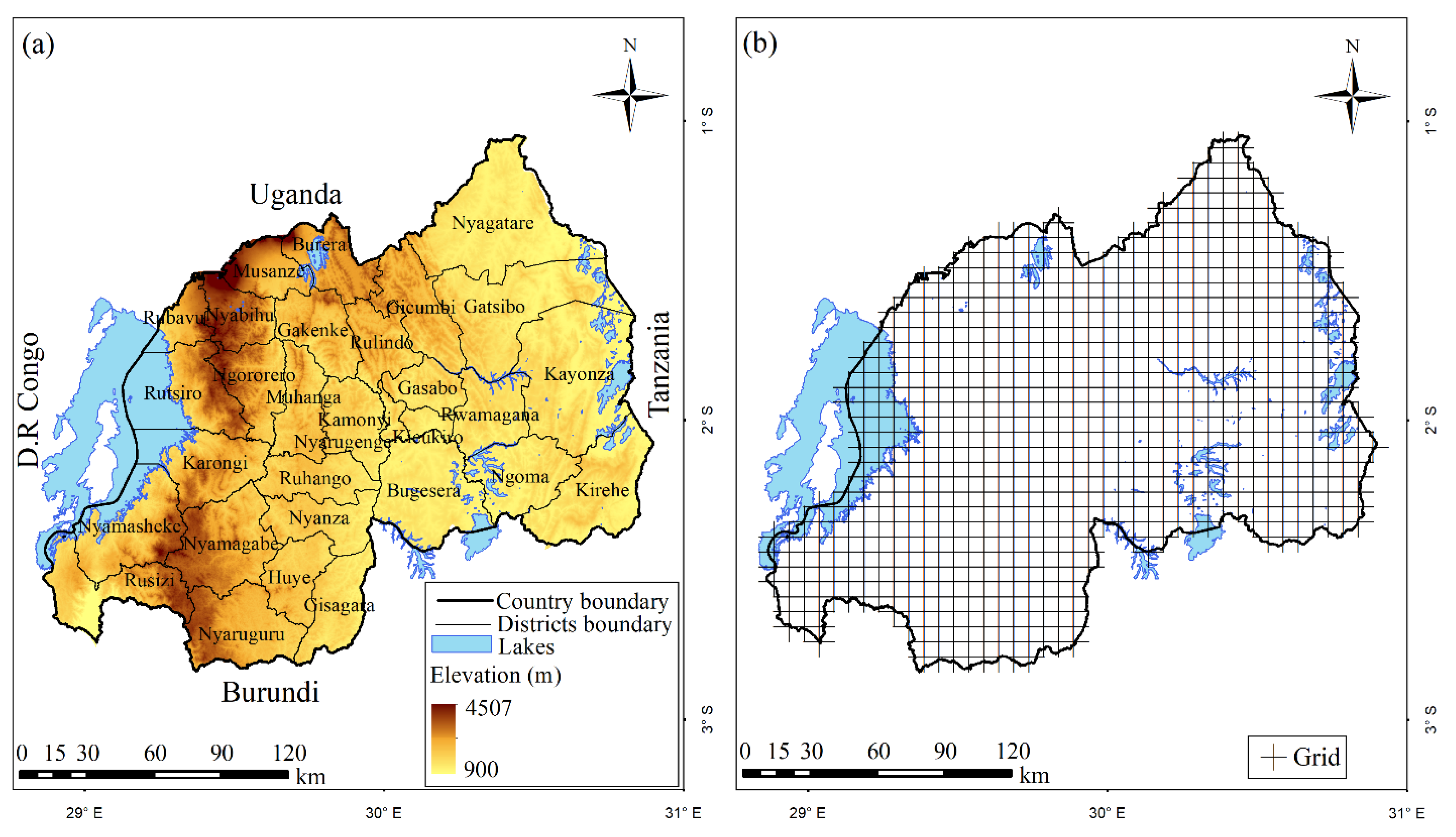
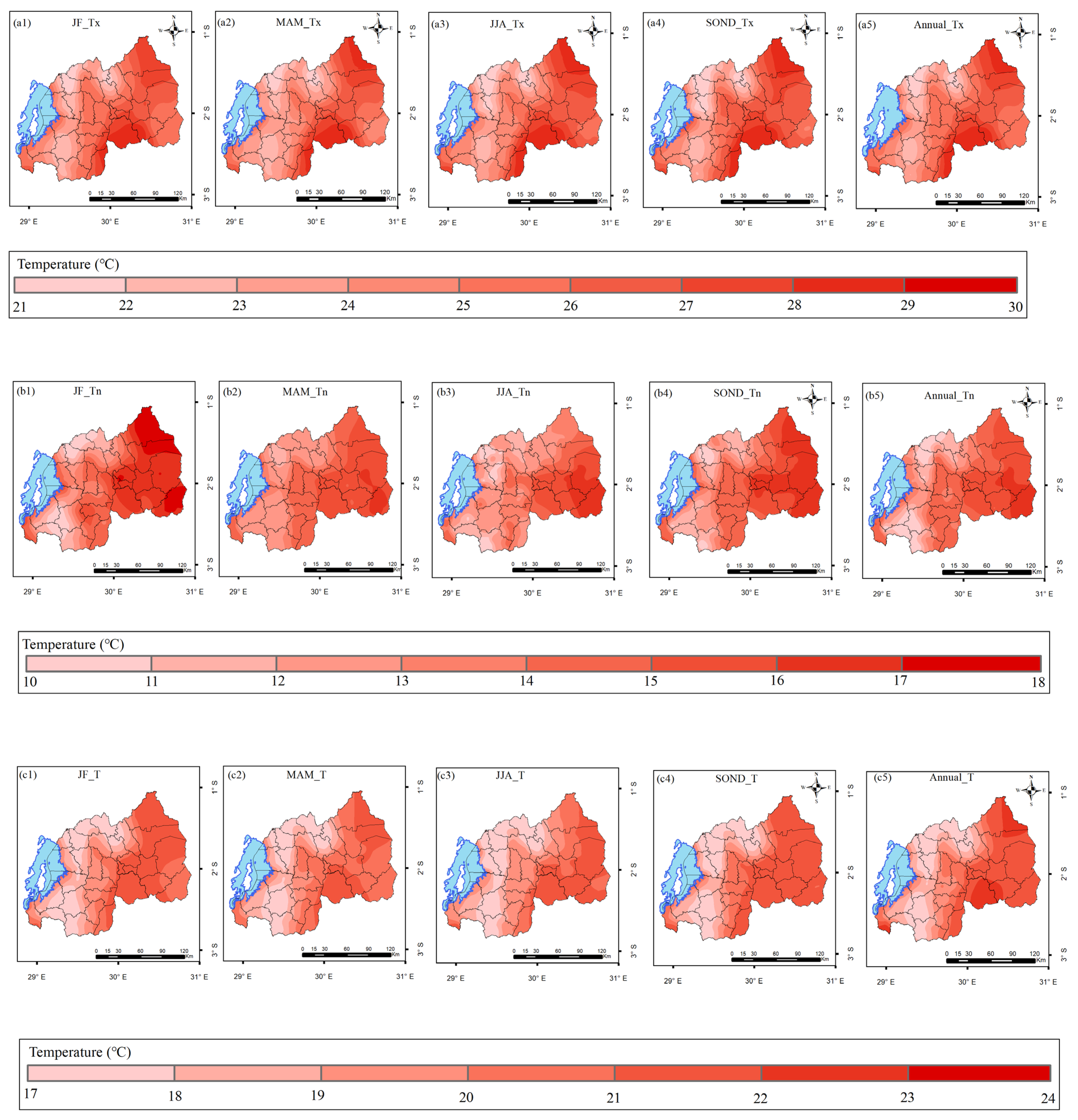
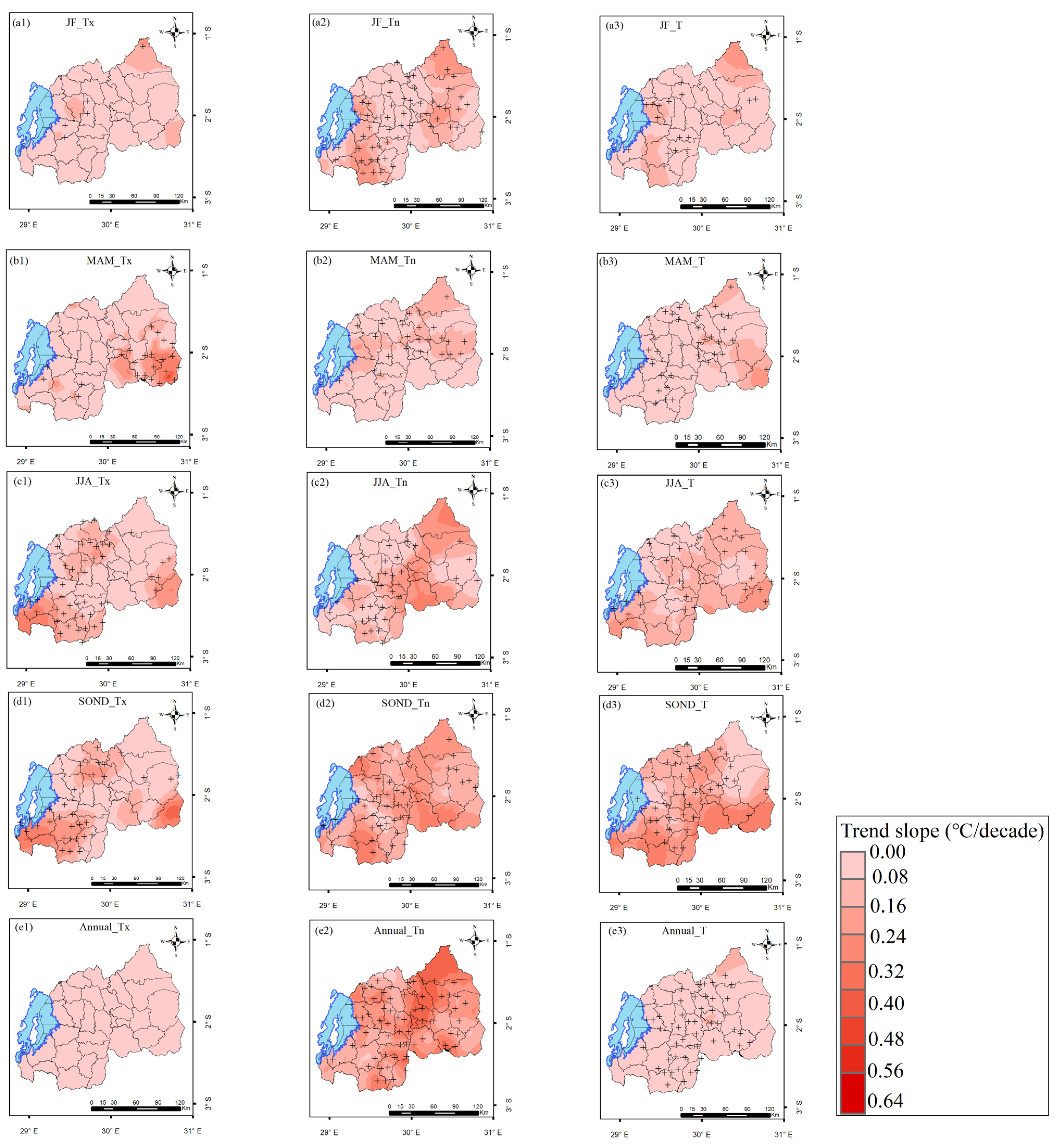
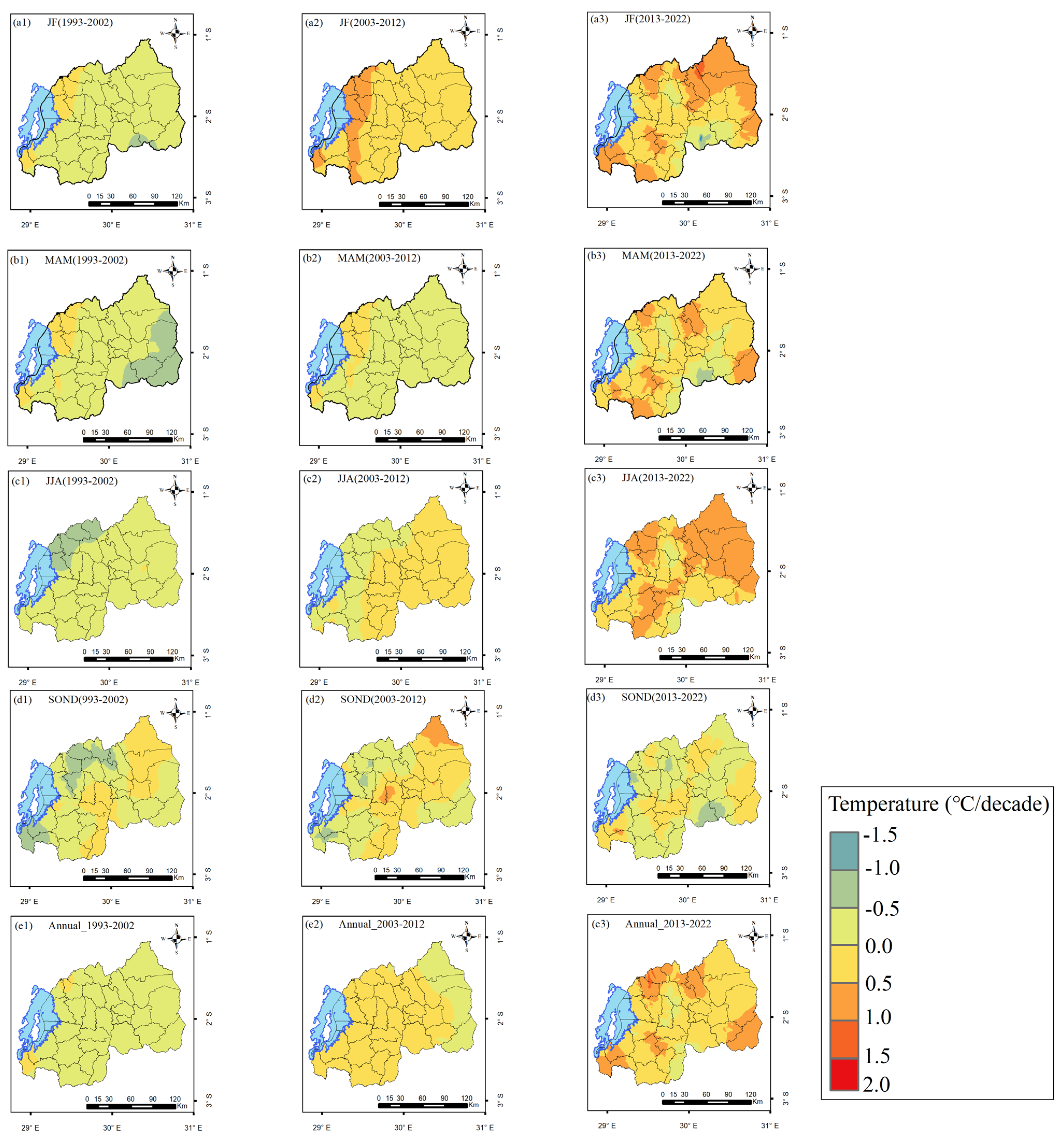

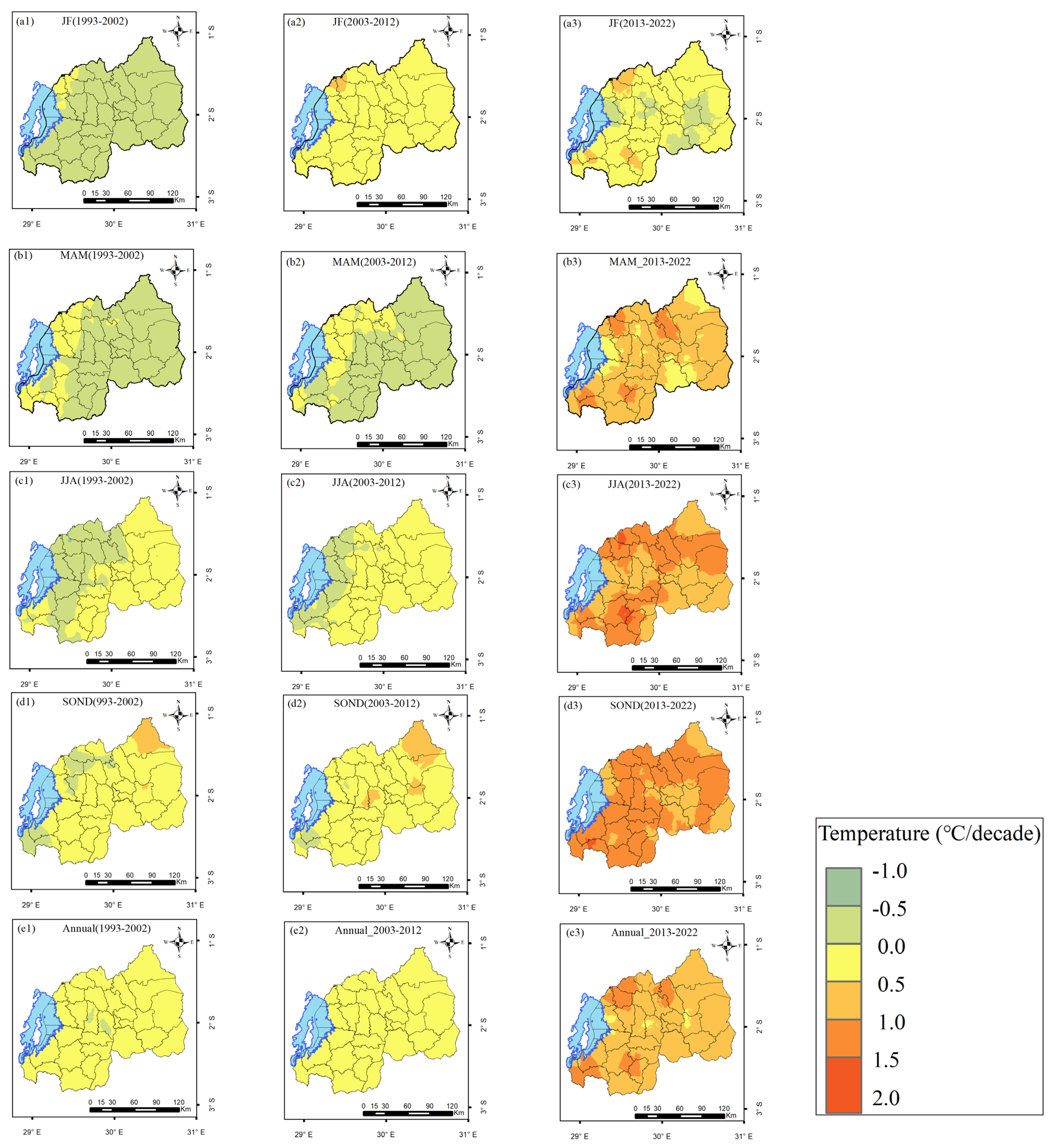
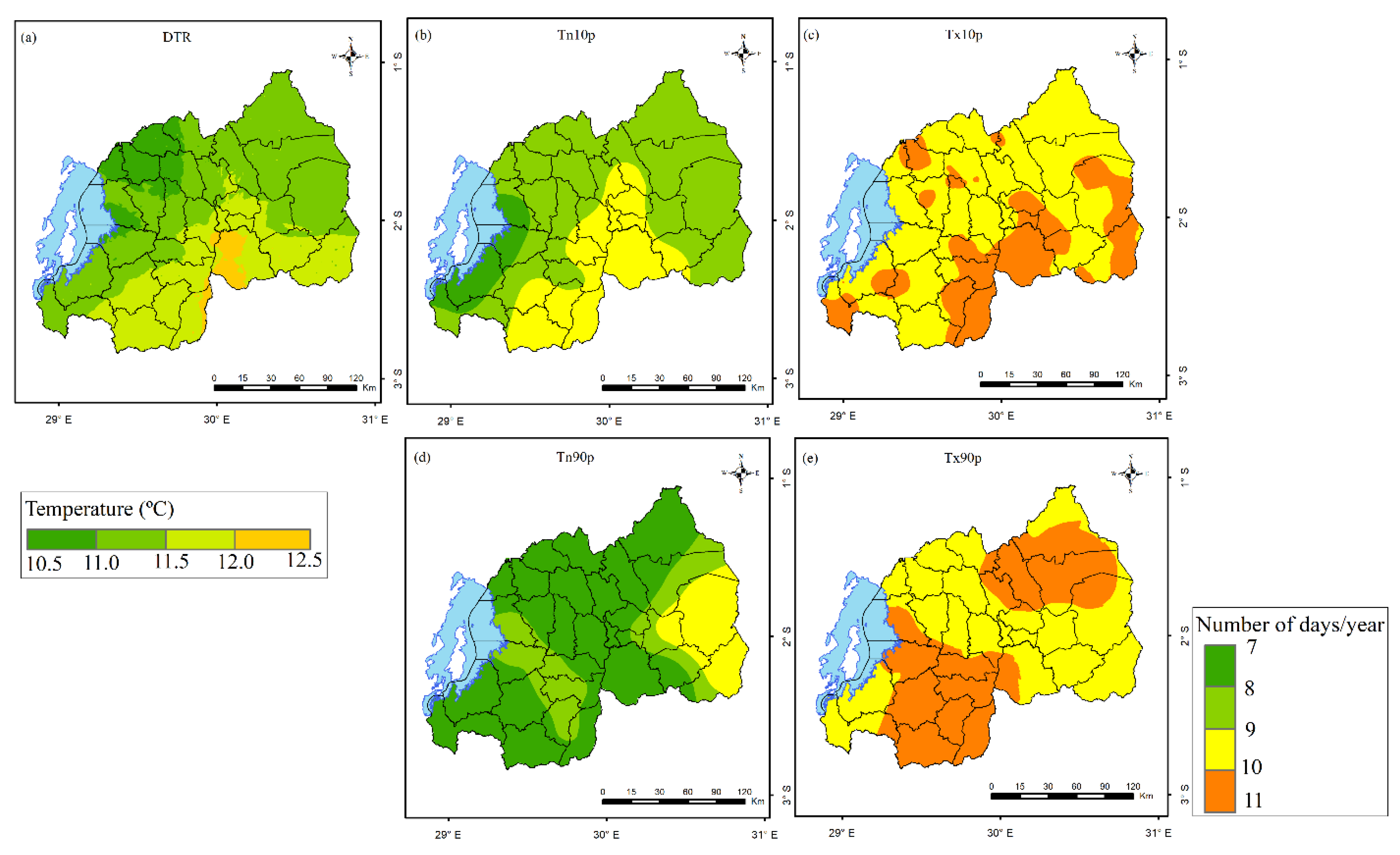
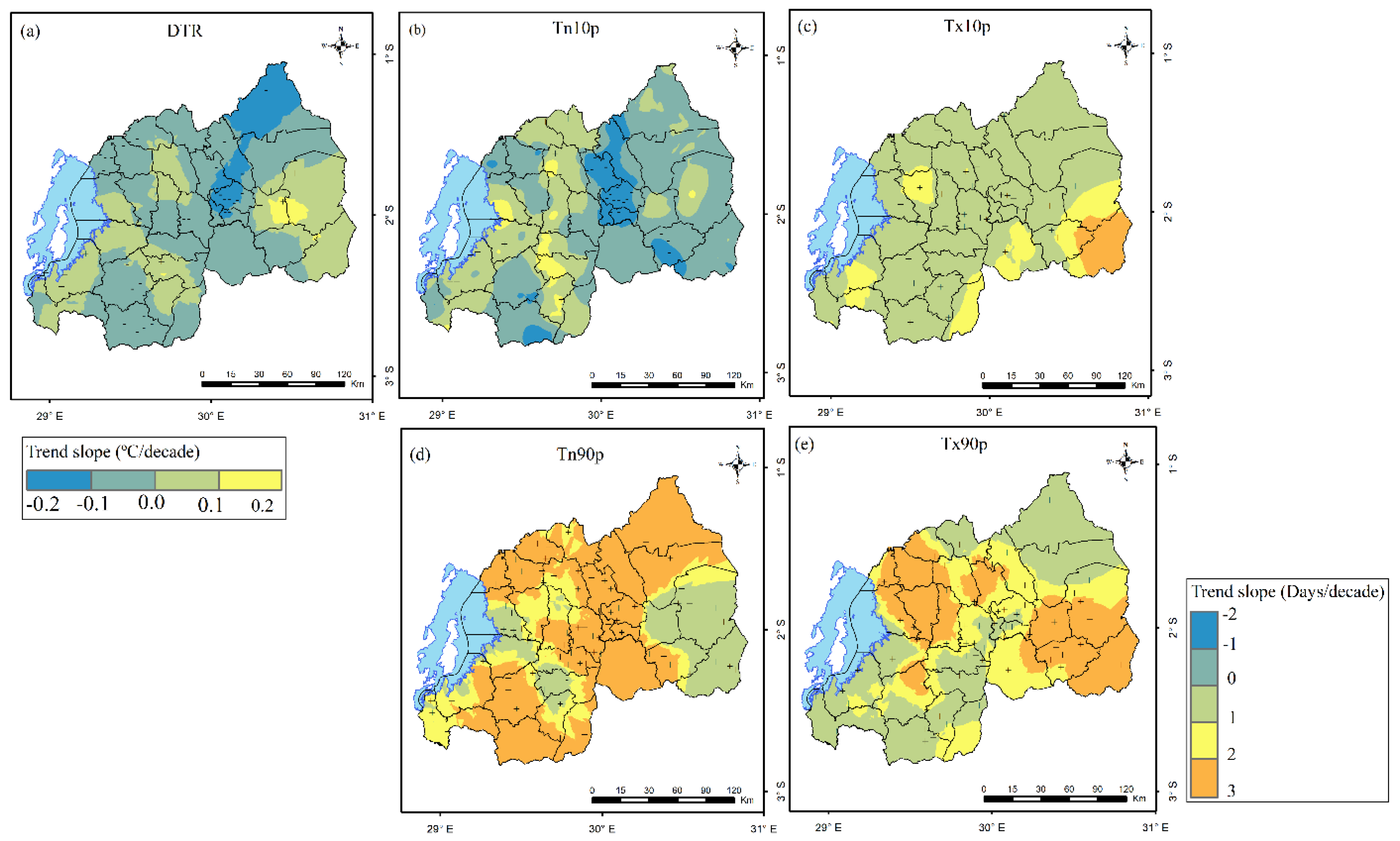
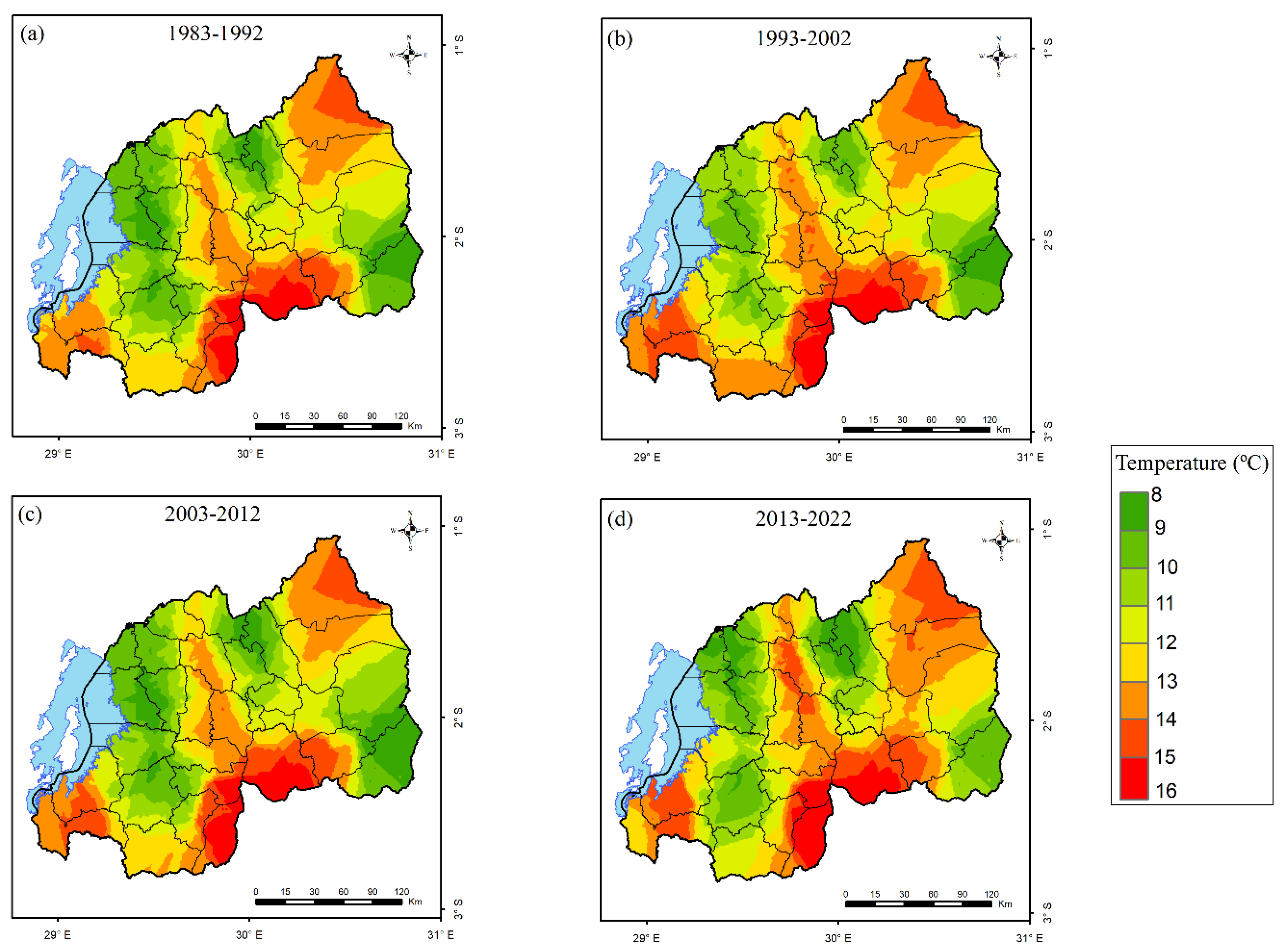

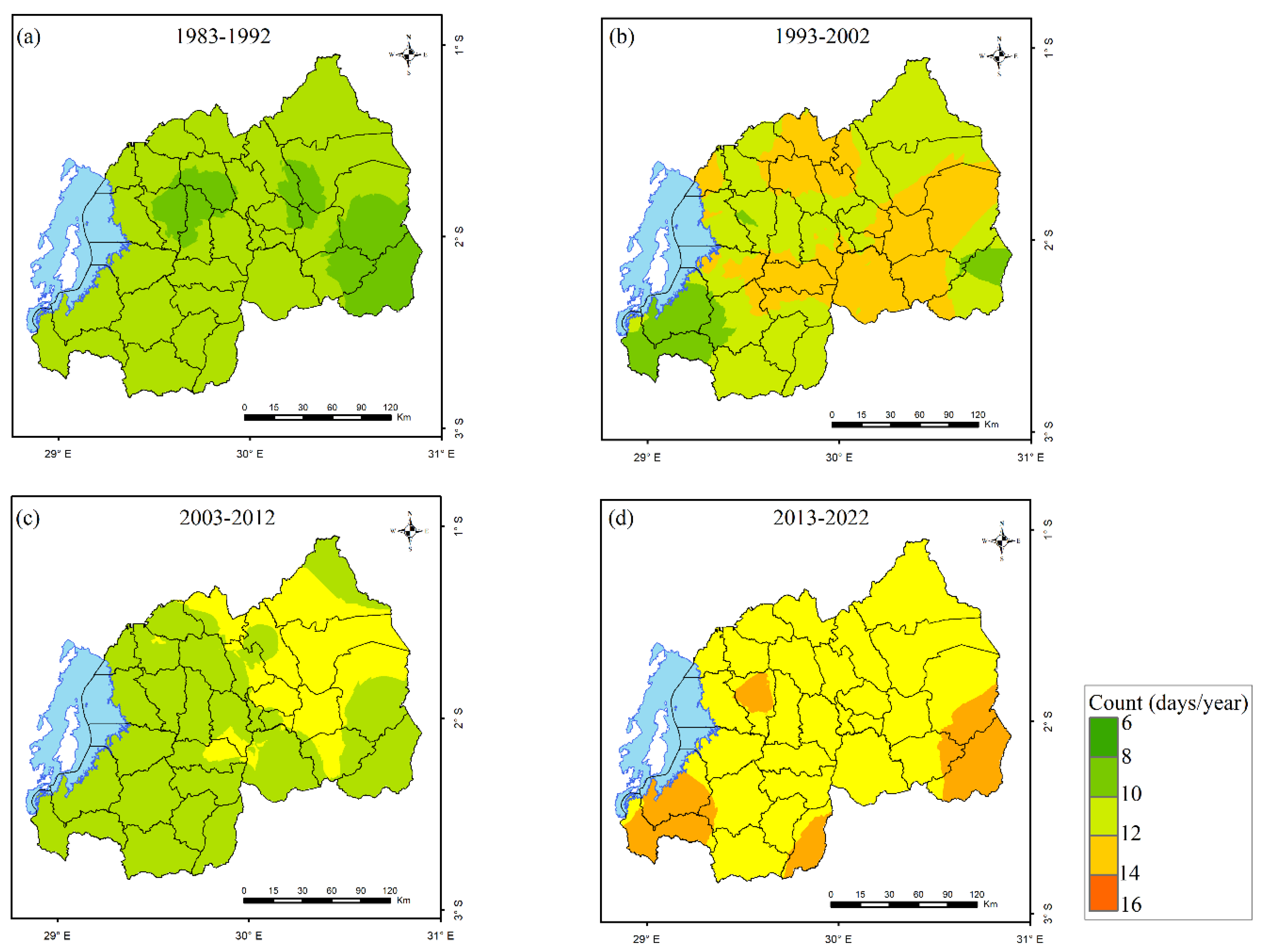
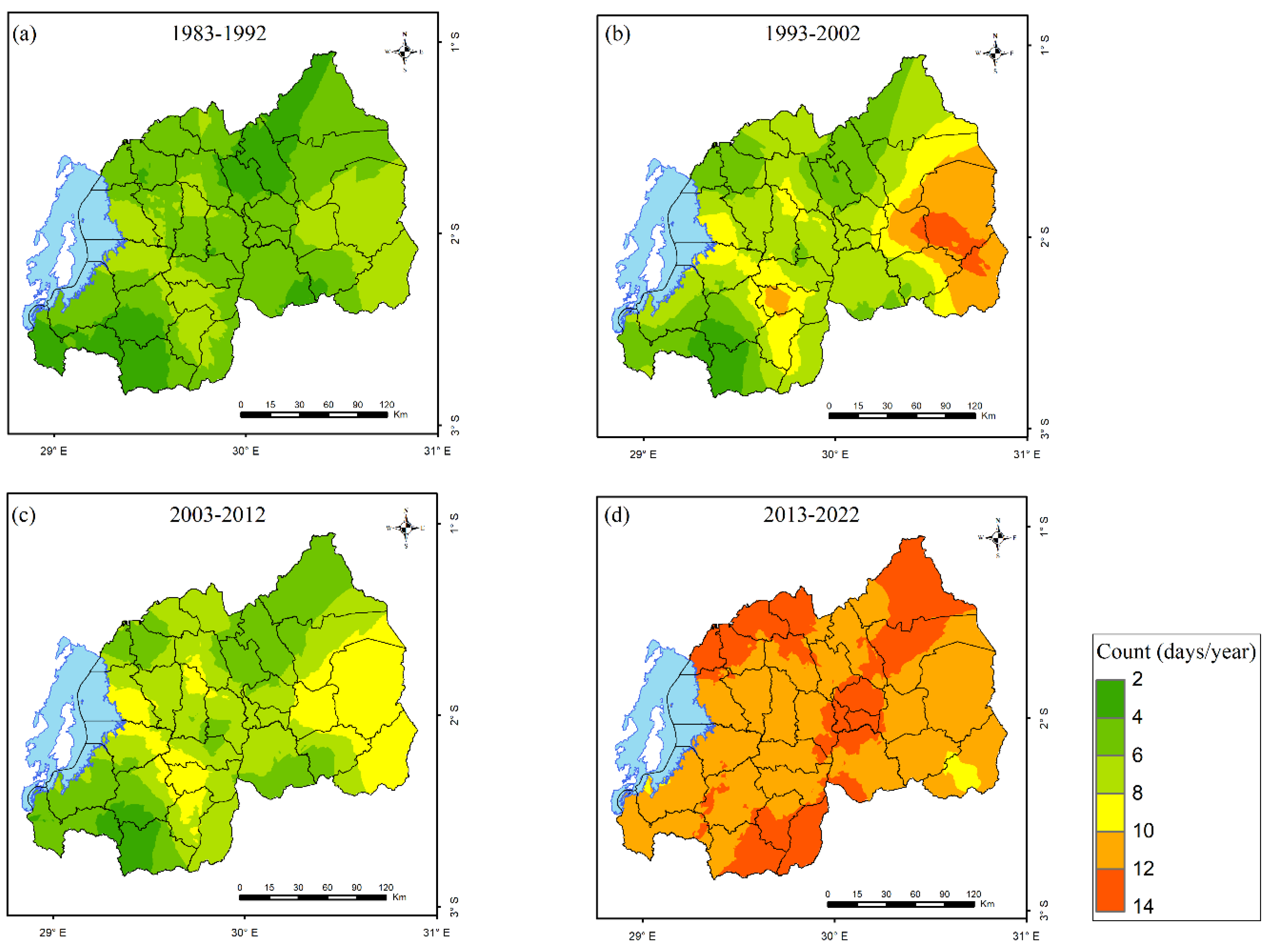
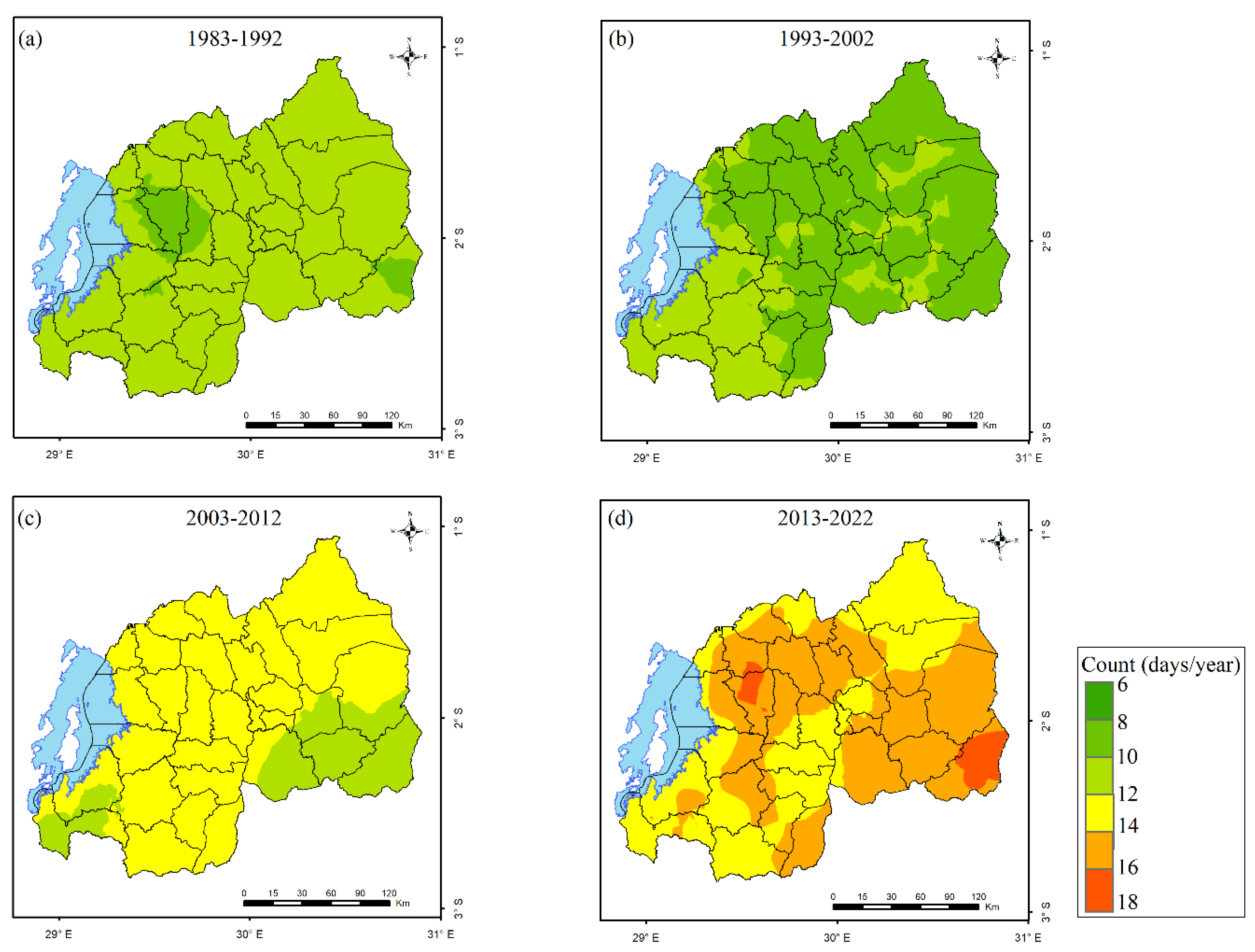
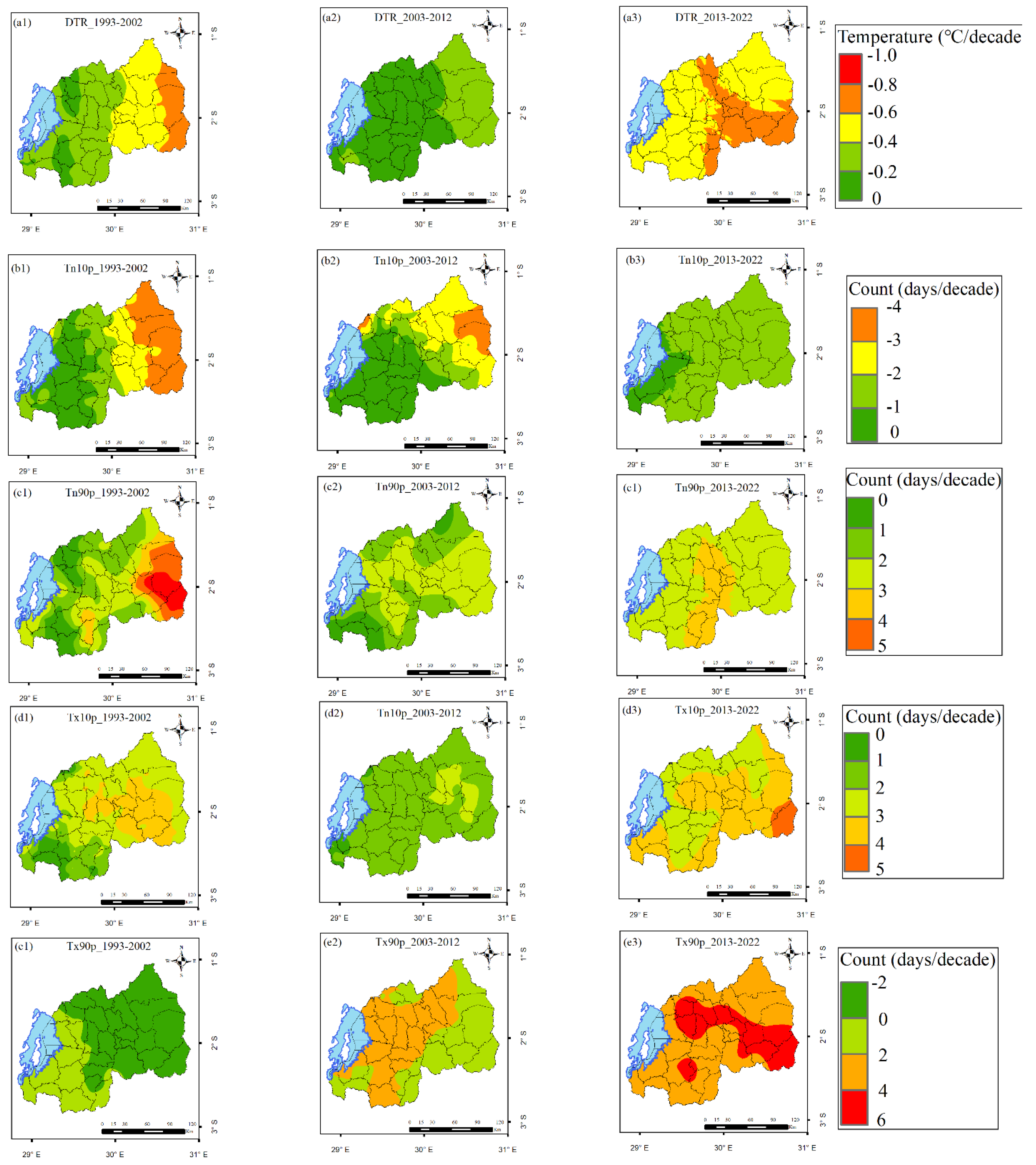
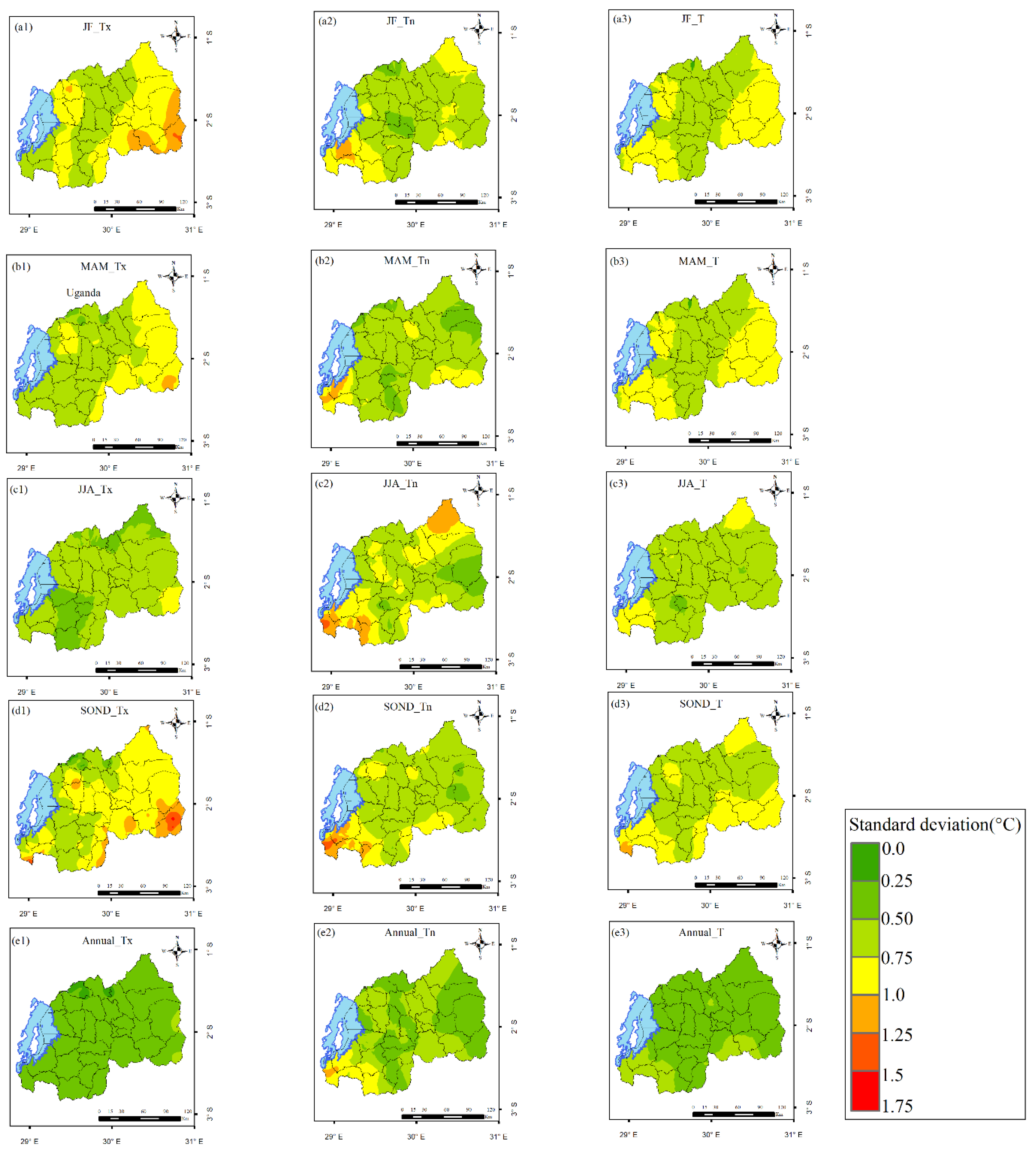
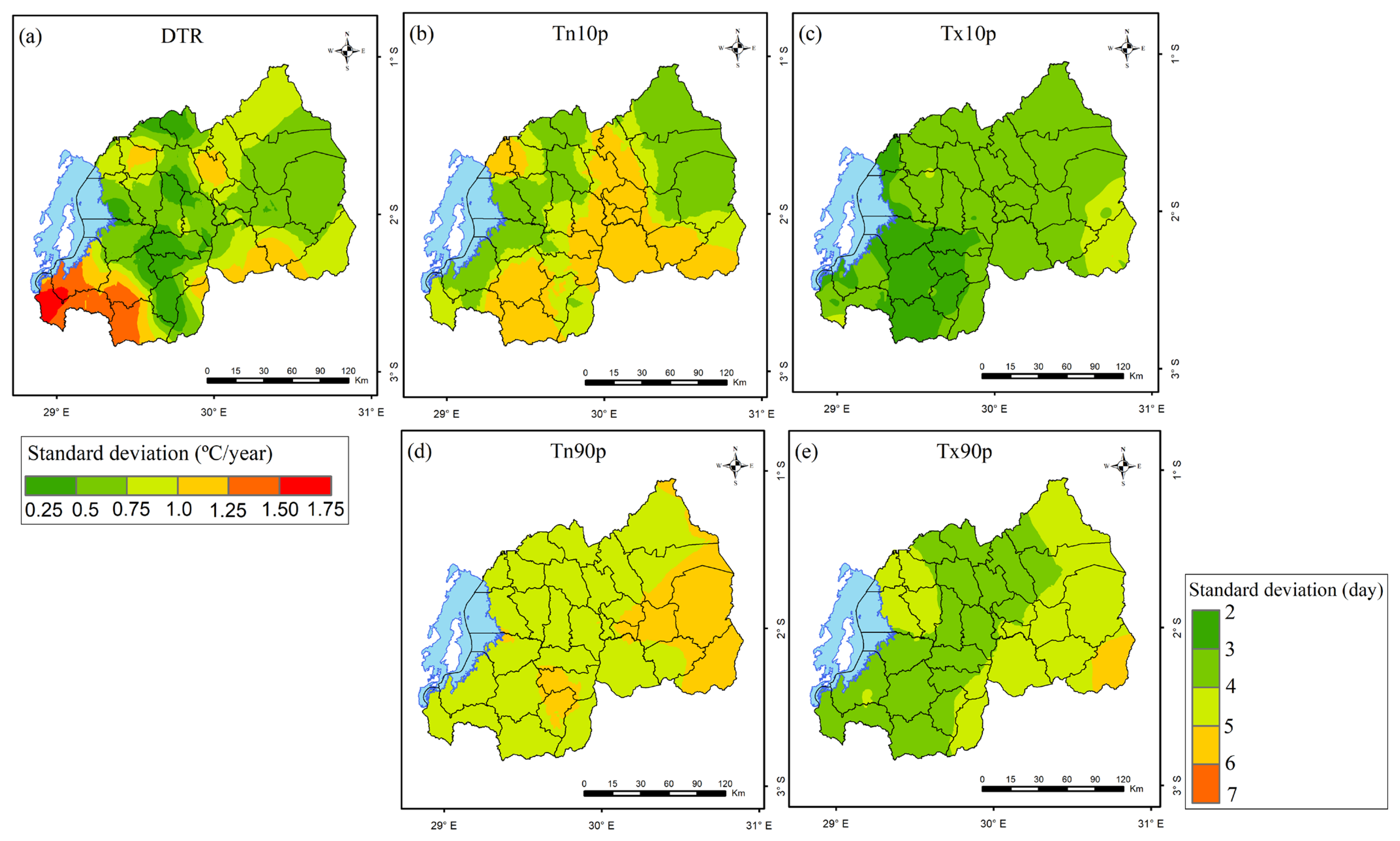
| Index | Description | Definition | Unit | Reference |
|---|---|---|---|---|
| DTR | Diurnal temperature range | Annual mean difference between daily maximum and minimum temperature | °C | Folland et al. [67] |
| Tn10p | Cold nights | Number of days in a year with minimum temperature below a threshold corresponding to 10th percentile of daily minimum temperature distribution in the 1991–2020 baseline period. | days/year | Karl et al. [63] Zhang et.al [64] Tank et al. [65] |
| Tx10p | Cold days | Number of days in a year with maximum temperature below a threshold corresponding to 10th percentile of daily maximum temperature distribution in the 1991–2020 baseline period. | days/year | Karl et al. [63] Zhang et.al [64] Tank et al. [65] |
| Tn90p | Warm nights | Number of days in a year with minimum temperature above a threshold corresponding to 90th percentile of daily minimum temperature distribution in the 1991–2020 baseline period. | days/year | Karl et al. [63] Zhang et.al [64] Tank et al. [65] |
| Tx90p | Warm days | Number of days in a year with maximum temperature above a threshold corresponding to 90th percentile of daily maximum temperature distribution in the 1991–2020 baseline period. | days/year | Karl et al. [63] Zhang et.al [64] Tank et al. [65] |
| Tn | |||||
| Season | Z | Tau | Sen’s Slope | p-Value | Significance |
| JF | 0.456 | 0.051 | 0.000 | 0.648 | No |
| MAM | 0.949 | 0.105 | 0.007 | 0.342 | No |
| JJA | 2.444 | 0.269 | 0.017 | 0.015 | Yes |
| SOND | 2.538 | 0.279 | 0.020 | 0.011 | Yes |
| ANNUAL | 2.063 | 0.227 | 0.013 | 0.039 | Yes |
| Tx | |||||
| Season | Z | tau | Sen’s Slope | p-value | Significance |
| JF | −1.133 | −0.126 | −0.010 | 0.257 | No |
| MAM | 1.358 | 0.150 | 0.013 | 0.174 | No |
| JJA | −1.535 | −0.169 | −0.010 | 0.125 | No |
| SOND | 1.367 | 1.367 | 0.010 | 0.172 | No |
| ANNUAL | 0.188 | 0.022 | 0.000 | 0.851 | No |
| T | |||||
| Season | Z | tau | Sen’s Slope | p−value | Significance |
| JF | −0.281 | −0.032 | 0.000 | 0.779 | No |
| MAM | 1.217 | 0.135 | 0.008 | 0.224 | No |
| JJA | 1.280 | 0.141 | 0.005 | 0.201 | No |
| SOND | 2.839 | 0.312 | 0.016 | 0.005 | Yes |
| ANNUAL | 1.708 | 0.187 | 0.007 | 0.088 | No |
| Season | Z | Tau | Sen’s Slope | p-Value | Significance |
|---|---|---|---|---|---|
| DTR | −2.307 | 0.255 | −0.014 | 0.021 | Yes |
| Tn10p | −0.851 | 0.095 | −0.049 | 0.395 | No |
| Tn90p | 1.317 | 0.146 | 0.062 | 0.029 | Yes |
| Tx10p | 2.342 | 0.259 | 0.084 | 0.019 | Yes |
| Tx90p | 2.552 | 0.282 | 0.128 | 0.011 | Yes |
Disclaimer/Publisher’s Note: The statements, opinions and data contained in all publications are solely those of the individual author(s) and contributor(s) and not of MDPI and/or the editor(s). MDPI and/or the editor(s) disclaim responsibility for any injury to people or property resulting from any ideas, methods, instructions or products referred to in the content. |
© 2023 by the authors. Licensee MDPI, Basel, Switzerland. This article is an open access article distributed under the terms and conditions of the Creative Commons Attribution (CC BY) license (https://creativecommons.org/licenses/by/4.0/).
Share and Cite
Safari, B.; Sebaziga, J.N. Trends and Variability in Temperature and Related Extreme Indices in Rwanda during the Past Four Decades. Atmosphere 2023, 14, 1449. https://doi.org/10.3390/atmos14091449
Safari B, Sebaziga JN. Trends and Variability in Temperature and Related Extreme Indices in Rwanda during the Past Four Decades. Atmosphere. 2023; 14(9):1449. https://doi.org/10.3390/atmos14091449
Chicago/Turabian StyleSafari, Bonfils, and Joseph Ndakize Sebaziga. 2023. "Trends and Variability in Temperature and Related Extreme Indices in Rwanda during the Past Four Decades" Atmosphere 14, no. 9: 1449. https://doi.org/10.3390/atmos14091449
APA StyleSafari, B., & Sebaziga, J. N. (2023). Trends and Variability in Temperature and Related Extreme Indices in Rwanda during the Past Four Decades. Atmosphere, 14(9), 1449. https://doi.org/10.3390/atmos14091449







